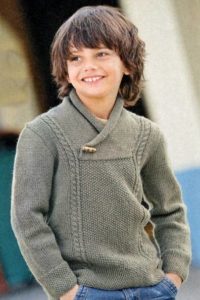 How adorable children look in knitted blouses. And there are so many different models of sweaters for boys. The eyes run wide from the bright models and all kinds of schemes. Where to begin? Read more about the most important details that a craftsman should consider when creating a sweater for a boy.
How adorable children look in knitted blouses. And there are so many different models of sweaters for boys. The eyes run wide from the bright models and all kinds of schemes. Where to begin? Read more about the most important details that a craftsman should consider when creating a sweater for a boy.
What you need to knit a sweater for a boy with knitting needles
 Any product requires a pattern and diagram. These are the very first steps that the craftswoman must take. Next, based on the model, yarn is selected. After the knitting needles, they should be the same size (this way the product will be denser and will retain its original shape for a long time).
Any product requires a pattern and diagram. These are the very first steps that the craftswoman must take. Next, based on the model, yarn is selected. After the knitting needles, they should be the same size (this way the product will be denser and will retain its original shape for a long time).
Important!
In many master classes that are available on the Internet, yarn is usually indicated and how much it will be needed for a certain size..
Pay close attention to the model itself and the pattern of the sweater fabric. If these are newfangled aranas, then they will require additional knitting needles (several). Special markers will help you not to get lost or break the pattern. About the intricacies of choosing tools and yarn.
Choosing good threads
Knowledge will help you avoid making mistakes in choosing yarn.The first thing to pay attention to is the composition. A knitter should know what each type of yarn is intended for. Briefly about the most popular types and where they are best used:
 Wool yarn (natural) - perfect for creating scarves, hats, socks, sweaters. It includes the following subspecies:
Wool yarn (natural) - perfect for creating scarves, hats, socks, sweaters. It includes the following subspecies:
- angora;
- mohair;
- cashmere;
- Shetland yarn;
- merino yarn;
- 100% wool;
- alpaca.
 Acrylic - this is already “artificial wool”. It is usually added to wool yarn. To create warm clothes, you need to choose yarn with an acrylic composition of 10–20 percent;
Acrylic - this is already “artificial wool”. It is usually added to wool yarn. To create warm clothes, you need to choose yarn with an acrylic composition of 10–20 percent;
 Cotton yarn - This is also a natural yarn and is more often used to make summer things. But it is intended mainly for crocheting;
Cotton yarn - This is also a natural yarn and is more often used to make summer things. But it is intended mainly for crocheting;
 Linen yarn - a type of natural yarn for creating summer clothes, a stiffer yarn;
Linen yarn - a type of natural yarn for creating summer clothes, a stiffer yarn;
 Silk yarn - has a decent appearance, some shimmer. In hot weather it retains a good feeling of coolness. Suitable for creating items that are not warm;
Silk yarn - has a decent appearance, some shimmer. In hot weather it retains a good feeling of coolness. Suitable for creating items that are not warm;
 Viscose - popular as “artificial silk”. Suitable for creating warm clothes, but it will be uncomfortable when warm;
Viscose - popular as “artificial silk”. Suitable for creating warm clothes, but it will be uncomfortable when warm;
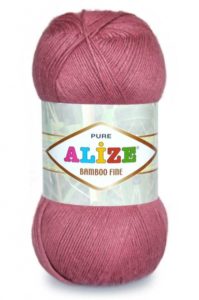 Bamboo - an excellent solution for creating children's things. The yarn has antibacterial properties, is very soft and hypoallergenic.
Bamboo - an excellent solution for creating children's things. The yarn has antibacterial properties, is very soft and hypoallergenic.
The second point that is worth considering is the thickness of the yarn; usually this information is also available in master classes.
And the third thing is the threads themselves. They must be uniform, without breaks or various defects.
Selecting tools
 Experienced craftsmen have already learned to determine by eye which knitting needles are suitable for what thickness of yarn. For beginners, the tips on the yarn package will help. If there are none, then you can ask the seller for advice. You can learn to determine the right size yourself.
Experienced craftsmen have already learned to determine by eye which knitting needles are suitable for what thickness of yarn. For beginners, the tips on the yarn package will help. If there are none, then you can ask the seller for advice. You can learn to determine the right size yourself.
Important!
Basic rule: “The knitting needle should be twice as thick as the thread.”To choose the size, you need to fold the sample into two threads and twist it - this will be the thickness of one knitting needle.
Additional knitting needles for making braids may also be different. There are also very comfortable short ones with a folded middle. These will not interfere with your work and will not fall off while the master is performing the braid element.
 There are different markers, but it is more convenient to buy bright and contrasting yarn options. They will help when counting loops. For example, they are convenient for the same braids; there should always be an equal number of loops between the intersections and the marker helps with this.
There are different markers, but it is more convenient to buy bright and contrasting yarn options. They will help when counting loops. For example, they are convenient for the same braids; there should always be an equal number of loops between the intersections and the marker helps with this.
Regular needles are not suitable for joining knitted items. Thicker needles will be needed.
Are measurements needed?
Knitted items, unlike others, do not require such scrupulousness in meticulous measurement. You can use two ways to create a gizmo:
- measure as you knit, simply applying the product to your model;
- Take a few measurements in advance and knit according to them.
There is also a table of standard sizes for boys.

A child does not always grow according to GOST indicators and therefore it is better to measure each indicator.
How to take measurements for a sweater
 For the sweater you will need to take only 6 measurements:
For the sweater you will need to take only 6 measurements:
- What sleeve length is needed - this is the measurement from the point of the shoulder to the wrist (be sure to pass the tape through the elbow).
- Neck circumference - this indicator will help you knit the right size collar for a sweater. To measure, apply the tape and do not tighten it; it should fit loosely around the neck.
- Back length. It does not always have to match the length of the product; more often the sweater is knitted with a small margin so that the back is always well covered. Plus an extra elastic band. The measurement itself goes from the lower cervical vertebra to the waist line.
- Chest circumference - at chest level.
- Waist circumference - if you need a strictly fitted product.
- The circumference of the hips is important for creating elastic so that the product does not pull and is not too loose.
Now let's start looking at popular knitting patterns.
Knitting a sweater for a boy: patterns with descriptions
 Without a doubt, the most popular knitting patterns for a boy's sweater are those that everyone loves arans. Model diagrams are no less popular raglan, and even simple pattern designs can create a fashionable product. Add a thick but soft thread to regular garter stitch and you can knit a creative pattern. Large voluminous buttons can serve as an excellent decoration element.
Without a doubt, the most popular knitting patterns for a boy's sweater are those that everyone loves arans. Model diagrams are no less popular raglan, and even simple pattern designs can create a fashionable product. Add a thick but soft thread to regular garter stitch and you can knit a creative pattern. Large voluminous buttons can serve as an excellent decoration element.
Children's sweater with collar and braid pattern
Sweater for a boy with a height of 110. An abundance of braids and a combination of pearl patterns are very popular solutions for 2018.
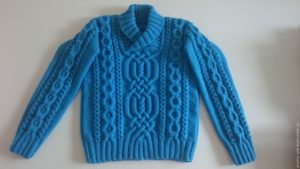
Required:
- Nako Bambino yarn 11.5 skeins;
- knitting needles number 3.5 and 4.5;
- stitching needle.
Several schemes were used in the work.
Pattern number 1 is the braids on the side of the front and back, and this is also a pattern of braids on the sleeves.

Pattern 2 is a regular pearl pattern; it dilutes the sleeves and the side parts of the front and back.

Pattern 4 is the elastic for the cuffs.
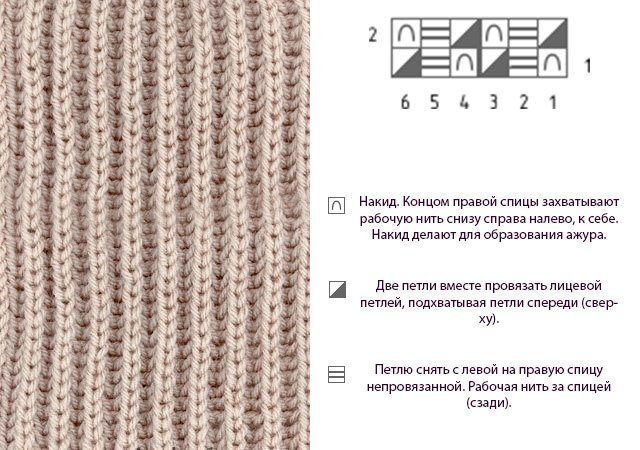
Between the patterns there is a purl stitch.
First stage: front and back
You will need to cast on 74 stitches on needles for this size. Knit with an elastic band 2*2. The height of the elastic should be 5 cm. In the last row you need to evenly add several loops so that you get 82 loops on the knitting needles. Then we immediately go to a combination of schemes, as in the photo. This is in the center - pattern number 2. On the sides there are two patterns 1 and 3. The remaining side loops are occupied by a pearl pattern. Knit according to the proposed patterns up to a height of 37 cm. Next, in the next row, bind off 4 loops for the sleeves.
Important!
For children's products, a square armhole is often used.
At a height of 43 cm, the formation of the neck begins. There is no need to bind off the stitches; you can simply transfer them to an additional needle. This will make it easier to make a neat gate later.
Separately knit the right and left shoulders, following the pattern of the fabric.
Make the second part in the same way; it is no different from the first.
Sew the shoulder seams and use circular needles to knit the neckline. This helps avoid unnecessary seam.
Second stage: sleeves
There is no need to sew on these sleeves. You just need to make a set along the edge of the armhole to the right and left of the canvas.
There are three pigtails in the center of each sleeve. For the left sleeve, three braids from pattern number 3 and pattern number 1 for the right. There is a pearl pattern on the sides of the braids. In total, you need to cast on 62 loops for the sleeve. Make decreases for the sleeve according to the scheme: after 5 cm, decrease one loop of each edge. After a length of 31 cm, move on to the cuffs. This is again a 2*2 elastic band. So knit 5 cm and close the loops.
Third stage: assembly
We hide the extra threads and simply sew the sides of the sleeves and the front and back. A sweater with original braids is ready.
Pullover with buttons for boys
A simple sweater made of canvas with an English rib pattern. Cuffs with elastic band 1*1, bottom and neck with elastic band 1*1. This is the same sweater. What boy didn’t want to try one of these on himself in the 2000s.

The sweater in which the main character of the film “Brother” appeared on the screen. A sweater like Danila’s is knitted using simple patterns.

Simple cut and large thread.
Back And before tied without armholes. Only a small neckline. For the front and back, use the basic English rib pattern. The cuffs and bottom of the product are 10 cm of 1*1 elastic.
Collar - this is also a 1*1 elastic band. Make holes (capes) for buttons along the edge of the collar.
Sleeves also made with English elastic. Such a simple model is now back in fashion. Therefore, all those who did not have time to try on such a sweater in 2000 can freely do so now.
Knitted striped sweater for a boy
Elegant wide stripes look noble on a boy's sweater. For the attention of needlewomen, another trash item is a model with comfortable buttons on the shoulders. It will be convenient for a child to put on and take off this model.
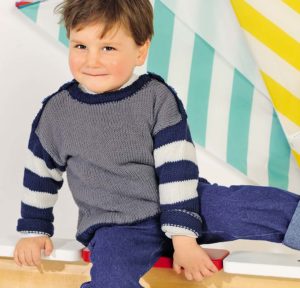
On a note!
You can choose stripes of other colors - one stripe takes up 10 rows.
The pattern for this piece is a simple stockinette stitch. For sleeves cuff made of rubber bands 2*2. The bottom of the back and front is also made with 2*2-10 cm elastic.
For back and front you need to cast on 80 loops for a height of 110 cm. No additions are needed, you just need to cast on 4 loops for the armhole. Make a slight bevel for the neckline. In this model, the back and front are knitted the same way. After creating the front and back, you need to draw a line where the buttons will be next. You need to pick up a loop along the top edge and knit 2–3 cm with an elastic band. Don’t forget to make two holes on the right and left shoulders.
On sleeves - cast on 60 loops and then add 2 loops every 5 cm along the edge of the fabric.
Then you need sew buttons symmetrical to the holes on the opposite side.
Fasten the buttons and sew on the sleeves. Sew the side seams and try on the sweater.
Sweater with jacquard knitting pattern
 A distinctive feature of such a contrasting sweater is its variety of tiny patterns. Contrasting threads make them even more expressive. Only the painstaking work is worth it, because such a beautiful product can be made with your own hands.
A distinctive feature of such a contrasting sweater is its variety of tiny patterns. Contrasting threads make them even more expressive. Only the painstaking work is worth it, because such a beautiful product can be made with your own hands.
For size 134/140 you need 200 g of sand-colored yarn, 50 g of other colors.

Sequence of patterns A-D.Knit the model in stockinette stitch using the jacquard technique.
For size 134/140 you need to cast on 109 stitches. Knit an elastic band for the back and front 10 rows and go to the canvas, adding 12 loops for each canvas. Knit 31 cm (for the back 33) and bind off the loops for the sleeve armhole with 8 loops. Next knit another 14 cm.
How to bind off front/back neck loops:
- close the central 31st points;
- twice two loops in the next rows;
- one time at a time.
Sleeves: Cast on 47 stitches and 10 rows of rib using knitting needles. Add 8 stitches on the last row. Switch to the main pattern and stockinette stitch. Next, add one loop in every 6th row. After 42 cm, close the loops.
Assembly: make shoulder seams and cast on 108 loops under the binding. Make a neat collar with an elastic band (this is 11 rows). Sew in the sleeves. Make side seams for the sleeves and the garment. That's all, the efforts are completed with an amazing result.
Tips for knitting a sweater for a boy
 There is no need to be afraid of complex elements. As soon as the most complex patterns are mastered, the interesting work of any needlewoman begins. So don't just stick to creating simple options. In fact, it turns out that a model that pleases our eyes is not so difficult to create.
There is no need to be afraid of complex elements. As soon as the most complex patterns are mastered, the interesting work of any needlewoman begins. So don't just stick to creating simple options. In fact, it turns out that a model that pleases our eyes is not so difficult to create.
For a boy's sweater, bulky buttons are often used - this emphasizes the masculine character of the sweater.



 0
0





